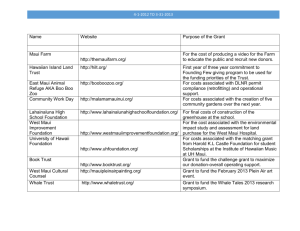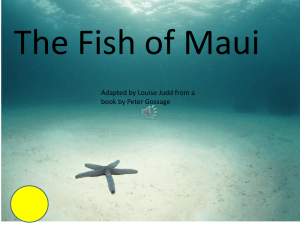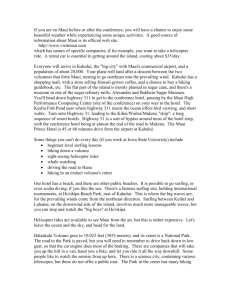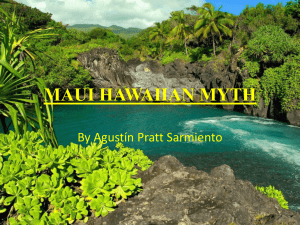Maui Island Plan Informational Presentation
advertisement
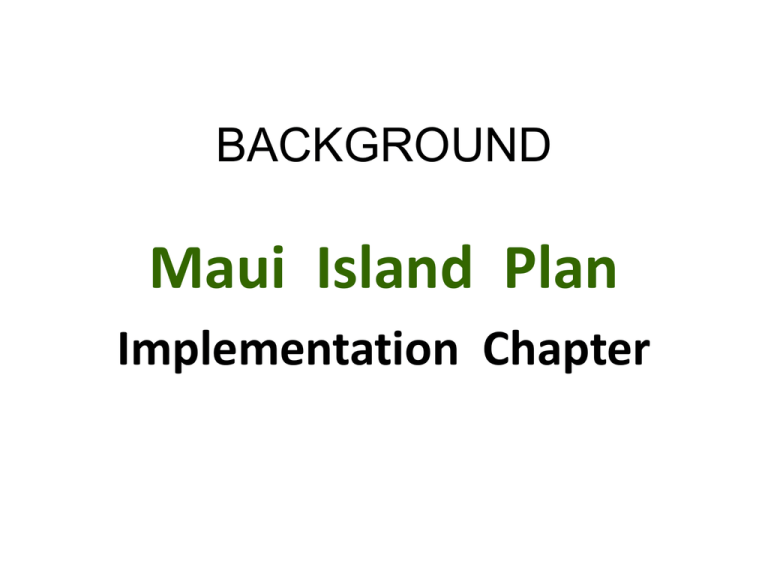
BACKGROUND Maui Island Plan Implementation Chapter Opportunity for Public Testimony 6PM, Wednesday, May 14, 2014 Maui County Council - Public Hearing OLD GENERAL PLAN PROCESS: County General Plan was very general plus 6 District Community Plans on Maui Island NEW GENERAL PLAN PROCESS: 1. Maui Countywide Policy Plan 2. Maui Island Plan 3. District Community Plans Maui County Code Chapter 2.80B.010 GENERAL PLAN AND COMMUNITY PLANS Purpose and intent . . . designed to provide plans that clearly identify provisions that are meant to be policy guidelines and provisions that are intended to have the force and effect of law; to implement and enforce plans through prioritization and accountability; and to increase public and community participation in the planning process. MAUI ISLAND PLAN APPROVAL PROCESS M.C.C. 2.80B GPAC Maui Planning Commission Planning Director All 3 versions went to the Council’s Planning Committee - but, only Planning Director’s version was used Council’s Planning Committee sent its recommendation to the full Maui County Council First Time for a “Maui Island Plan” 2003-2006 – Background studies: Housing, Infrastructure, Environment, etc. 2003+2004 – MEDB “ Maui Nui Project; 1,700 residents in “focus-group” sessions 2005 – 25 member GPAC selected by Mayor + Council; 25 residents 2006+2007 – County Wide Policy Plan 2008 + 2009 – GPAC - Maui Island Plan Maui Island Plan has 3 Planning Components: 1. Policies and Actions – 9 Chapters 2. Land Use Growth Boundaries maps Urban; Small Town; Rural 3. M.I.P. -- Implementation Program Oct-2009 May-2014 @ Maui County Council 4 ½ Years 2.80B.030.G.4 MAUI ISLAND PLAN IMPLEMENTATION PROGRAM a. CAPITAL IMPROVEMENT ELEMENT - regional infrastructure systems and regional public facilities b. FINANCIAL ELEMENT - fiscally sound financial program for identified actions and capital improvements c. IMPLEMENTATION SCHEDULE - identify and numerically prioritize specific actions, the implementation actions’ commencement and completion dates, the lead implementation agency or person, the estimated implementation cost, and the anticipated funding source or sources NEEDED TO BE RESTORED TO THE IMPLEMENTATION CHAPTER Each community plan district shall have its own permanent Community District Planning Advisory Committee. Hana already has such an Advisory Board; and Molokai and Lanai even have their own Planning Commissions. Five 5 Maui Island districts where most of the development and decision-making is taking place have no advisory capacity. West, Central, and South Maui, Upcountry, and Paia-Haiku Insert: “The Council shall establish permanent Community Plan Advisory Committees, their rules and responsibilities, and the mechanism to select the members.” NEEDS TO BE RESTORED TO THE IMPLEMENTATION CHAPTER Relevance of Old Documents Very often the planning commissions, other county commissions, and the County Council will be asked to make decisions based on information contained in documents prepared many years earlier. (For example, a traffic study completed six years earlier may no longer be valid.) INSERT: “All studies and documents completed more than five years prior to an application shall be considered "out of date," unless the decision-making body affirms by a positive vote that the document is still timely and relevant.” NEEDS TO BE RESTORED TO THE IMPLEMENTATION CHAPTER Need for Neutral Environmental Reviews Proposals to change land uses are often accompanied by a required environmental assessment (EA) or environmental impact statement (EIS) prepared by a consultant hired and paid for by a developer. Because the consultants may owe their allegiance to the developer, and not to the general public for whom the environmental document is being prepared, the general public is not best served by this approach. Therefore, EA and EIS documents shall be prepared by a consultant selected by and under the direction of the Planning Department; the consultant shall be paid by the developer making a proposal. This same practice shall be utilized for State projects being proposed to be built within Maui Island. The County shall select the environmental consultant, and the State shall pay for the consultant. INSERT: “EA and EIS documents shall be prepared by a consultant selected by and under the direction of the Planning Department; the consultant shall be paid by the developer making a proposal.” NEEDS TO BE RESTORED TO THE IMPLEMENTATION CHAPTER On page 10-4 in the next to the last paragraph, change the word “may” back to “shall”. “To ensure that no ambiguities exist regarding infrastructure funding responsibilities, the County may shall establish an infrastructure funding strategy to ensure that infrastructure improvements are implemented prior to or concurrent with development by the responsible party depending on the nature of the infrastructure project.” -----------------------------------------------------------------------------------The listing of potential revenue sources that was included in the GPAC and Maui Planning Commission recommendations (GPAC Recommendation, Tables 9-1 and 9-2) was deleted in the Planning Director’s recommendation (Table 10-1 on Page 10-6). It is important to restore the two GPAC tables (Tables 9-1 and 9-2) in the implementation program, just as they were worded in the GPAC recommendation. NEEDS TO BE RESTORED TO THE IMPLEMENTATION CHAPTER INSERT: “All future Community Plan and Zoning Entitlements shall have a fixed time limit, to discourage ‘land-banking’, to provide for more stable employment opportunities, and to ensure smooth planning. The entitlement may be considered void, unless an appeal for an extension of 2 years has been approved by the County Council.” Opportunity for Public Testimony 6PM, Wednesday, May 14, 2014 Maui County Council - Public Hearing Explanation The next 2 slides are examples of the text in the existing first 9 chapters of the Maui Island Plan. These 9 chapters have already been made Maui County law. Thereafter, there are 6 maps that show the growth boundaries in upcountry and north Maui. Red areas are Urban growth areas. Yellow areas are Small Town growth areas. Light blue areas are Rural growth areas. MAUI ISLAND PLAN -- Policy Examples Agriculture and Energy Security Food and Energy Security “Diversified local food production can help buffer our food supplies by reducing our dependency on imported foods. Moreover, local agriculture can deliver fresher, and more flavorful and nutritious alternatives when compared to many mainland and foreign agricultural products. Energy crops are an emerging agricultural industry that has the potential to significantly increase Maui’s energy security and the demand for agricultural land.” Stewardship of Land and Water “Unlike urban development, agriculture protects land use options for future generations. In addition, agriculture gives residents a connection to the land and promotes the stewardship of natural resources.” (SEE Chapter 7, Page 7-3 and the following pages.) MAUI ISLAND PLAN -- ENERGY SUSTAINABILITY “Growing crops that can be processed to generate electrical power or to make fuel will provide agricultural jobs, utilize agricultural lands, and make Maui more energy self-reliant. “The economic feasibility of energy crops for biofuels depends largely on factors in the sugar and oil markets, and alternative uses for land. Only land zoned for agriculture is likely to be available for energy crops. Market forces appear to be working in favor of biofuel development on Maui. “Potential synergies and trade-offs between dedicating land to biofuel crops for automotive fuels versus utility-scale power generation should be further examined. Potential areas identified for biomass energy crop production include former Lahaina plantation land; HC&S land in Pā`ia; and HC&S land in Pu`unēnē. Potential also exists on Upcountry ranch lands.” (SEE Chapter 4, Page 4-16 and the following pages.) Hali’imaile Makawao Pukalani Pukalani Upper Kula Waiakoa Keokea Ulupalakua Paia Town Ku’au Pa’uwela Ha’iku
